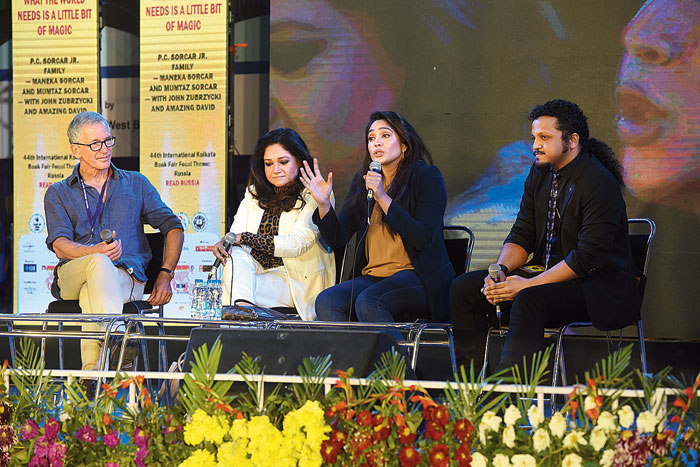The session ‘What the World needs is a little bit of magic’ had magician Maneka Sorcar, actress Mumtaz Sorcar, daughters of P.C. Sorcar Junior, and John Zubrzycki, Sydney-based author, researcher and journalist, in conversation with illusionist Amazing David at the Kolkata Literature Festival recently, in association with The Telegraph. The talk unfurled like an elaborate magic-trick-in-the-making that literally ended with the ‘first ever magic trick performed in public’ by John Zubrzycki. Conjured around the discussion of the book Jadoowallahs, Jugglers and Jinns: A Magical History of India by John Zubrzycki, the discussion stirred up memories of Mumtaz and Maneka Sorcar’s growing up in a family of magicians, the experience of penning the book for John Zubrzycki, looking at the world at large through ‘magic-tinted’ spectacles as the all-subsuming philosophy in everything and more.
Why magic?
“Who doesn’t love to be spellbound? Who doesn’t want to wonder if what they’ve seen is actually real or they’ve been tricked? That’s just the wider picture. As a historian I wanted to bring to life the very extraordinary rich heritage that India has had in magic …” said John to start the session. Situating magic at the very heart of Calcutta in context of the Kolkata Literary festival, he added, “Calcutta is one of my favourite cities, it is always a pleasure to come back. It is the city of magic in many senses of the word.”
Stirring the Cauldron of magical memories
Mumtaz recounted her experience of visiting boimela with her father for the launch of his books and then coming in for her film promotions. “Chhotobelay there was this trick where Baba used to perform a trick of slicing mother in two! We used to get very scared in our childhood, but soon it turned the other way round,” she laughed, eliciting a round of laughter in turn from the audience. She went on to define magic as the “fusion of science and arts” and as something “created in the mind”. Likening her career of “facing the magic of facing camera every day” to “Baba acting the role of a magician on stage”, her childhood was full of magic. Maneka added her mix of memories, reminiscing fondly about Samrat, the Serengeti lion, who was “Baba’s favourite”, and a “Dada” to them and who used to lie down under their bed. Zubrzycki took us through his tryst with Indian magic in 1979 at Alipur Duar, where he saw an “old jaaduwala” performing the famous basket trick. “My train was stuck and so I had wandered out of the station. There was an old jaaduwala who was performing the basket trick. It’s the trick where the magician has a basket and his assistant, usually a young boy, climbs into the basket. After putting the lid on the basket, the jaaduwala stabs the boy with sharp swords and knives. The boy screams out loud as the sword is taken out and blood spills out. This continues until the screams of the boy become softer, making him seem dead to the audience. Finally, the trick hits the crescendo when the boy is lifted out of the basket shortly after with the knife through his neck,” he explained.
Of Madaaris and the magic of Indian magic in the West
The figure of the madaari , the traditional magicians who performed adroitly on the streets in the presence of a huge swarm of viewers, were lauded as “the true magicians” of India, who have laid the very foundation of Indian magic as we have known it.“When the madaaris performed, they would be surrounded by public from all corners! Moreover, they had minimal props for their tricks, and yet they performed them with such skill and dexterity! Madaaris are our true gurus. Many of the Indian magic tricks were actually taken abroad and re-styled and put up to stage,” said Maneka.
Expressing her disapproval of the usage of the term ‘street magic’, she foregrounded the tangible endeavour of Senior and Junior P.C. Sorcar in “uplifting the traditional Indian magicians performing on the street sides and corners through Madari Manch.”
The impact of Indian magic on the western conjuring tradition was such that western magicians would pose as Indian jaaduwalas, replicating Indian magic tricks. “Harry Houdini actually started his career by putting boot polish on his face,” revealed Amazing David.
On continuing the spell of magic...
Maneka vehemently denied the notion of magic being a dying art and directed the onus of sustaining the art of magic upon each one of us. “In my grandfather’s time, magic was seen as mantra, tantra, hocus-pocus, but not anymore. Magic is but the forerunner of science; what we know as magic today, will become science tomorrow! What is science today was magic yesterday as has been said by P.C. Sorcar Junior. Magic is a mark of excellence, a degree of excellence.”
Maneka rested her case, drawing in nods and murmurs of approval from the audience, which turned to applause and cheers shortly after when John Zubrzycki took to the stage and performed his magic trick successfully.
As the all-about-magic session came to a close,we were reminded of Roald Dahl’s quote, ‘Those who don’t believe in magic will never find it.’ After all, it all comes down to living up the very charm of life as it is, to find and do magic in what we do, and the rest, would be nothing short of a magic trick in itself.











